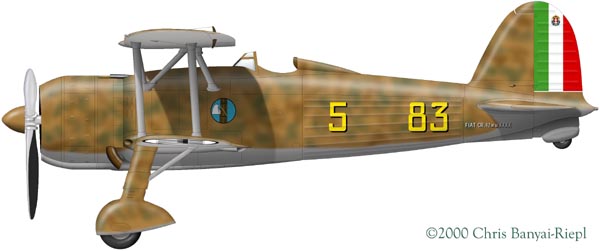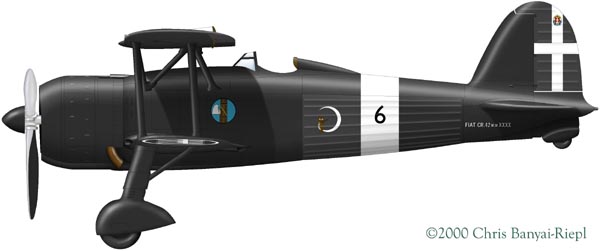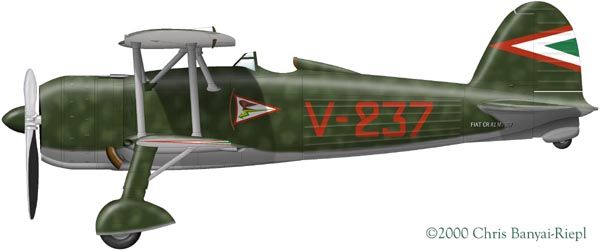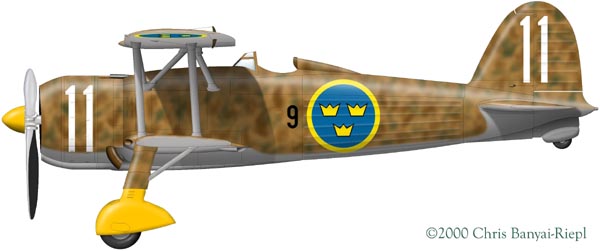The Biplane's Final Chapter, Italian Style
The Fiat CR.42 in Italian and Foreign Service
by Chris Banyai-Riepl
The Second World War saw some great advances in aviation technology, culminating in jet and rocket powered aircraft. With such marvels to behold one small fact is often overlooked and that is the last biplane fighters. In 1945 it would seem absurd to have a biplane fighter on the front lines but only five years earlier biplanes were still very much a part of many air forces. One of the finest biplane fighters of all time has to be the Fiat CR.42. This plane was such a pleasure to fly that when the more modern MC.200 became available there was at least one squadron that refused to switch from their trusty CR.42s.
Several foreign countries also flew the CR.42, with most keeping the Italian camouflage scheme. Below is a small collection of CR.42s from around Europe.
Fiat CR.42, 5-83
83a Squadriglia, 18° Gruppo
Mondavi, Italy, 1939
Before the Second World War started, Italian aircraft carried the national colors on the rudder, as seen on this example. The green/white/red rudder colors were changed to the more familiar white cross after the war started to avoid confusion with French planes. This particular plane hasn't had the unit badge painted on yet. The camouflage is standard Italian three-color of Giallo Mimetico 3 (sand), Marrone Mimetico 2 (brown), and Verde Mimetico 3 (green) over Grigio Mimetico (gray) undersurfaces.
Fiat CR.42, Black 6
377a Squadriglia
Palermo-Boccadifalco, 1942
In Italian service the CR.42 quickly found itself relegated to secondary squadrons, where it found a new home in the form of a night fighter. As a night fighter the CR.42 found decent success, as its shortcomings were negated by the dark of night. This CR.42 from 377a Squadriglia is black overall, with a white fuselage band. The underwing roundels are a reverse of the normal roundel, consisting of a white circle and fasces. The night fighter emblem is on the fuselage and consists of a white moon with an owl perched on the corner, shouldering a rifle.
Fiat CR.42, FOL-4
Scuola Caccia di Foligno
1942
Another use of the CR.42 in Italian service was that of a trainer. Its great handling characteristics, both on the ground and in the air, made it an excellent choice to bridge the gap between the basic trainers and the final fighters. This example is finished in Verde Oliva Scuro 2 (dark olive green) over Grigio Azzurro Chiaro 1 (light blue gray), with white bands on the fuselage and wings. Standard roundels are on the wings. Note the bare landing gear, a common sight as the wheel spats tended to get clogged with dirt and mud.
Fiat CR.42, V-237
2/4 Vadàsz Szàdad "Tör" (Dagger)
1941
Hungary was another big user of the Fiat CR.42, with 72 being purchased. These planes went through a number of different camouflages and markings throughout their life in the Hungarian Air Force. This example has a dark green base with light green mottling over a light gray. The fuselage codes are in red and the Hungarian national markings consist of a red/white/green chevron on the tail and wings. The unit badge is a flying pennant with a winged lightning bolt.
J 11 (Fiat CR.42), White 11
Flottilj 9, Flygvapnet
1941
Although it didn't see combat, the Fiat CR.42 also found its way into the Swedish Air Force, with 72 planes purchased. The J 11, as the CR.42 was called in Sweden, served from 1940 to 1945, making the Swedish planes the last operational examples flying. They retained their Italian camouflage throughout their career, and carried the Swedish roundel on the fuselage and lower wings only. White numbers are on the cowl and tail, while the wing number is in black ahead of the fuselage roundel.

Fiat CR.42, White 5
4ème Escadrille, IIème Groupe de Chasse
Aéonautique Militaire
Nivelles, Spring 1940
Belgium had a short life with the CR.42 as well, receiving 30 planes, all of which served with the 2nd Fighter Group. When Germany invaded, the majority of CR.42s were destroyed on the ground, with only 5 escaping destruction. Belgian CR.42s were in the original Italian camouflage, with the Belgian roundel on the fuselage and wings. The white 'cocotte' in front of the fuselage roundel is the 4ème Escadrille emblem, dating back to the days of World War 1.









